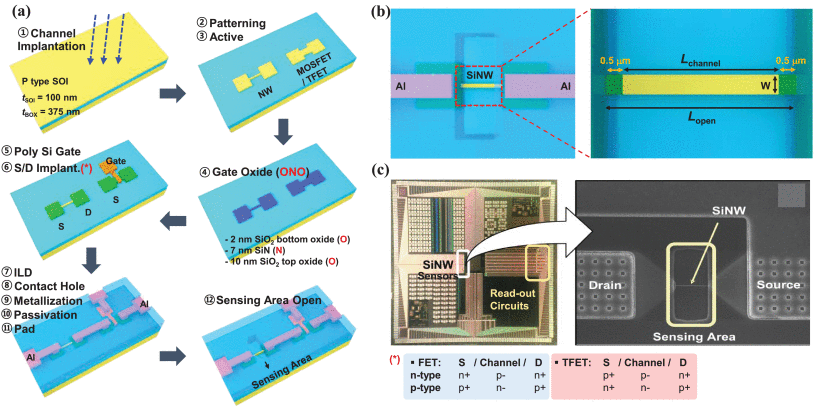Multiplexed Silicon Nanowire Tunnel FET-Based Biosensors With Optimized Multi-Sensing Currents
The comparable size of the biomolecules like proteins, viruses, and DNA to nano-sized biomolecules has led to the study of various nano-scale biomedical sensors used for detection. Also, several chemical and biomedical sensors using fluorescent labeling and optical monitoring have attracted attention for their high sensitivity. However, they are expensive and take time to detect. Hence, the researchers proposed the silicon nanowire (SiNW) ion sensitive field effect transistors (ISFETs) as promising chemical/biomedical sensors to overcome the constraints. It has the advantages of label-free and real-time detection with excellent sensitivity due to its high surface-to-volume ratio.
Recently, a novel, highly sensitive SiNW field-effect transistor (FET) biosensor with co-integrated CMOS read-out circuits through standard CMOS processes was demonstrated successfully. Here, SiNW FET-based and SiNW tunnel FET (TFET)-based biosensors are co-integrated with CMOS circuits. The possibility of multiplexed sensing with a single device is especially verified by the fabricated SiNW FET and TFET biosensors.
The paper proposes to solve the practical problems of early-reported multiplexed FET biosensors using the gate-induced-drain-leakage (GIDL) current multiplexed TFET biosensor. The proposed TFET sensor utilizes the unique bidirectional ambipolar tunneling current of TFETs for a distinctive detection of two bio-targets through a single biosensor with almost the same sensing currents and higher sensitivity than FET-based sensors. Due to its area/power efficiency, the proposed sensor would be practical in multiplexed diagnostic devices, particularly mobile appliances.
To verify the high sensitivity of the SiNW TFET sensors, SiNW FET and SiNW TFET sensors were co-integrated with CMOS circuits using top-down approaches and CMOS-compatible processes. Here, the oxide-nitride-oxide (ONO) insulator scheme was adopted to obtain the sensors with defect-free sensing oxide and threshold voltage (Vth)-tunable CMOS devices for read-out circuits.
The key process of the multiplexed biosensors fabrication is to implement the two distinct receptors (gold binding protein (GBP)-avian influenza (AI) and silica binding protein (SBP)- H1N1) for individual target nanomaterials (anti-AI and anti H1N1). The gold is successfully attached to the entire surface of the SiNW channel except for the drain region using the high-resolution lift-off process.
It is verified through the electrical measurements that the TFET sensor has superior sensitivity over the FET sensor, especially at low overdrive voltages. It is an excellent advantage for a low-power mobile application. The multiplexed sensing of FET and TFET sensors was also successfully verified.
However, the FET-based sensors for multiplexed sensing have two serious problems: First, the levels of two distinct sensing currents (on-current and GIDL current) are highly different, thus bringing out the complexity of the read-out. Second, depending on the position of the gold layer, a significant variation in sensitivity can be induced.
The TFET sensors can solve the mentioned problems by using the on-current and symmetric ambipolar current generated locally on the source and the drain edge. The evident threshold voltage shifts or the conductance modifications induced by GBP-AI / Anti-AI attachments are demonstrated in the on-current region and SBP-H1N1 / Anti-H1N1 attachments in the ambipolar region, respectively. Their independent modulations were also carefully verified.
The proposal and results of the paper confirm the applicability of highly-scaled, CMOS-compatible, and low-power multiplexed-biosensor, which can break new ground for mobile diagnostic devices.




